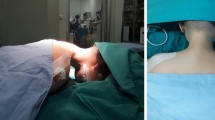Summary
Herniated nuclear material of the cervical disc often perforates the posterior longitudinal ligament. Of 22 patients who were operated on by an anterior approach, 10 were of this type (the subligamentous type of cervical disc protrusion), while in the remaining 12 patients and 15 discs the protruded disc caused no tear in the ligament (the epiligamentous type). Myelography and CT myelography of these patients were reviewed. On CT myelography a localized and sharply demarcated excavation of the metrizamide ring was commonly found in the subligamentous type. Myelographic lateral view in this group shows a moderate or large indentation of the metrizamide column, since the herniated nucleus pulposus sometimes migrates caudally or cephalically. A small myelographic deformity coupled with diffuse excavation of the metrizamide ring on a CT myelogram leads us to the diagnosis of the epiligamentous type of cervical disc protrusion. In such cases, excision of the ligament is unnecessary during exploration of the discs, except when there is marked depression in the posterior longitudinal ligament. Presurgical recognition of both anatomical processes must be stressed for anterior discectomy.
Similar content being viewed by others
References
Coin CB, Coin JT (1981) Computed tomography of cervical disk disease. J Comput Assist Tomogr 5: 275–280
Miyasaka K, Isu T, Iwasaki Y, Abe S, Takei H, Tsuru M (1983) High Resolution Computed Tomography in the Diagnosis of Cervical Disc Disease. Neuroradiology 24: 253–257
Frykholm R (1951) Lower cervical vertebrae and intervertebral discs. Surg Anat Pathol 101: 345–359
McRae DL (1956) Asymptomatic intervertebral disc protrusions. Acta Radiol 46: 9–27
MacNab I, McCulloch JA, Weiner DS, Hugo EP, Galway RD, Dall D (1971) Chemonucleolysis. Can J Surg 14: 280–289
Stookey B (1928) Compression of the spinal cord due to ventral extradural cervical chondromas. Arch Neurol Psychiatry 20: 275–291
Bollati A, Galli G, Gandolfini M, Marini G, Gatta G (1983) Microsurgical anterior cervical disk removal without interbody infusion. Surg Neurol 19: 329–333
O'Laoire SA, Thomas DGT (1983) Spinal cord compression due to prolapse of cervical intervertebral disc (herniation of nucleus pulposes). J Neurosurg 59: 847–853
Epstein JA, Carras R, Epstein BS, Levine LS (1970) Myelopathy in cervical spondylosis with vertebral subluxation and hyperlordosis. J Neurosurg 32: 421–426
Penning L (1962) Some aspects of plain radiography of the cervical spine in chronic myelopathy. Neurology (Minneap) 12: 513–519
Taylor AR (1953) Mechanism and treatment of spinal-cord disorders associated with cervical spondylosis. Lancet I: 717–720
Schmidek HH, Sweet WH (1982) Operative neurosurgical techniques: anterior cervical disc excision in cervical spondylosis. Grune and Stratton, New York, pp 1237–1257
Author information
Authors and Affiliations
Rights and permissions
About this article
Cite this article
Isu, T., Iwasaki, Y., Miyasaka, K. et al. A reappraisal of the diagnosis in cervical disc disease: the posterior longitudinal ligament perforated or not. Neuroradiology 28, 215–220 (1986). https://doi.org/10.1007/BF00548195
Received:
Issue Date:
DOI: https://doi.org/10.1007/BF00548195




